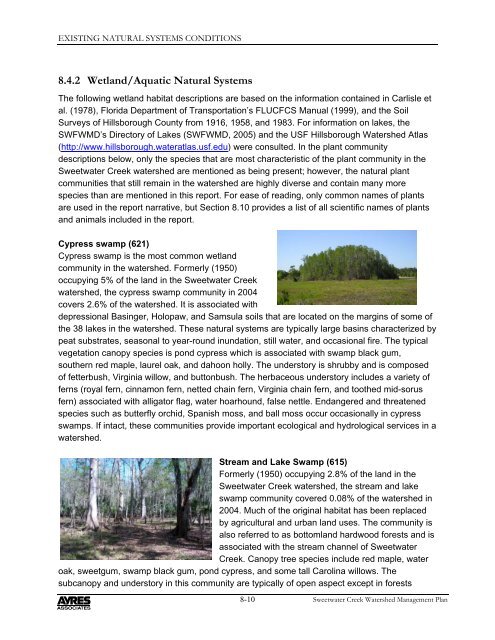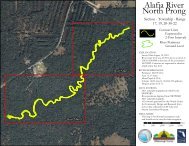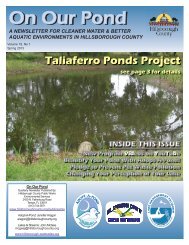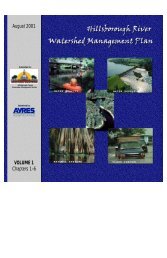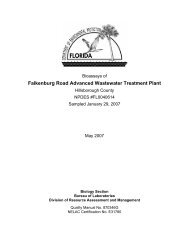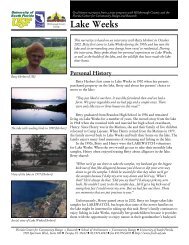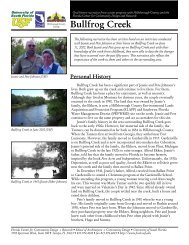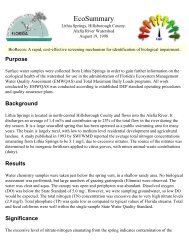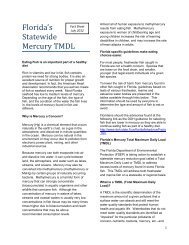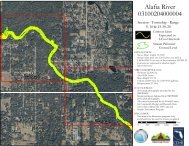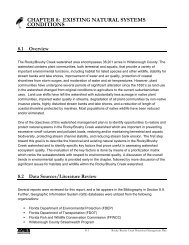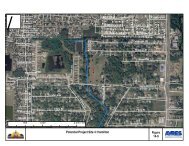Sweetwater Creek Watershed Mgmt. Plan 2007 Update--Part 2
Sweetwater Creek Watershed Mgmt. Plan 2007 Update--Part 2
Sweetwater Creek Watershed Mgmt. Plan 2007 Update--Part 2
You also want an ePaper? Increase the reach of your titles
YUMPU automatically turns print PDFs into web optimized ePapers that Google loves.
EXISTING NATURAL SYSTEMS CONDITIONS<br />
8.4.2 Wetland/Aquatic Natural Systems<br />
The following wetland habitat descriptions are based on the information contained in Carlisle et<br />
al. (1978), Florida Department of Transportation’s FLUCFCS Manual (1999), and the Soil<br />
Surveys of Hillsborough County from 1916, 1958, and 1983. For information on lakes, the<br />
SWFWMD’s Directory of Lakes (SWFWMD, 2005) and the USF Hillsborough <strong>Watershed</strong> Atlas<br />
(http://www.hillsborough.wateratlas.usf.edu) were consulted. In the plant community<br />
descriptions below, only the species that are most characteristic of the plant community in the<br />
<strong>Sweetwater</strong> <strong>Creek</strong> watershed are mentioned as being present; however, the natural plant<br />
communities that still remain in the watershed are highly diverse and contain many more<br />
species than are mentioned in this report. For ease of reading, only common names of plants<br />
are used in the report narrative, but Section 8.10 provides a list of all scientific names of plants<br />
and animals included in the report.<br />
Cypress swamp (621)<br />
Cypress swamp is the most common wetland<br />
community in the watershed. Formerly (1950)<br />
occupying 5% of the land in the <strong>Sweetwater</strong> <strong>Creek</strong><br />
watershed, the cypress swamp community in 2004<br />
covers 2.6% of the watershed. It is associated with<br />
depressional Basinger, Holopaw, and Samsula soils that are located on the margins of some of<br />
the 38 lakes in the watershed. These natural systems are typically large basins characterized by<br />
peat substrates, seasonal to year-round inundation, still water, and occasional fire. The typical<br />
vegetation canopy species is pond cypress which is associated with swamp black gum,<br />
southern red maple, laurel oak, and dahoon holly. The understory is shrubby and is composed<br />
of fetterbush, Virginia willow, and buttonbush. The herbaceous understory includes a variety of<br />
ferns (royal fern, cinnamon fern, netted chain fern, Virginia chain fern, and toothed mid-sorus<br />
fern) associated with alligator flag, water hoarhound, false nettle. Endangered and threatened<br />
species such as butterfly orchid, Spanish moss, and ball moss occur occasionally in cypress<br />
swamps. If intact, these communities provide important ecological and hydrological services in a<br />
watershed.<br />
Stream and Lake Swamp (615)<br />
Formerly (1950) occupying 2.8% of the land in the<br />
<strong>Sweetwater</strong> <strong>Creek</strong> watershed, the stream and lake<br />
swamp community covered 0.08% of the watershed in<br />
2004. Much of the original habitat has been replaced<br />
by agricultural and urban land uses. The community is<br />
also referred to as bottomland hardwood forests and is<br />
associated with the stream channel of <strong>Sweetwater</strong><br />
<strong>Creek</strong>. Canopy tree species include red maple, water<br />
oak, sweetgum, swamp black gum, pond cypress, and some tall Carolina willows. The<br />
subcanopy and understory in this community are typically of open aspect except in forests<br />
8-10<br />
<strong>Sweetwater</strong> <strong>Creek</strong> <strong>Watershed</strong> Management <strong>Plan</strong>


